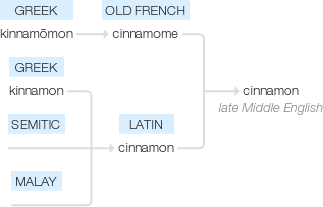Cinnamon
late Middle English: from Old French cinnamome (from Greek kinnamōmon ), and Latin cinnamon (from Greek kinnamon ), both from a Semitic language and perhaps based on Malay.
wiktionary
From Middle English synamome, from Old French cinnamone, from Latin cinnamon, cinnamōmum, from Ancient Greek κιννάμωμον(kinnámōmon), later κίνναμον(kínnamon), probably to be explained as “Chinese amomum”, ἄμωμον(ámōmon) being, only cognate to Classical Syriac ܚܡܵܡܵܐ (ḥəmāmā) and Arabic حَمَامَا (ḥamāmā), a phytonym of lost provenience for a varied genus Amomum of spice and drug plants; compare for this composition the Iranian designation دارچین (dârčin, literally “Chinese tree”).
etymonline
cinnamon (n.)
spice obtained from the dried inner bark of a tree in the avocado family, late 14c., from Old French cinnamone (13c.), from Latin cinnamum, cinnamomum "cinnamon" (also used as a term of endearment), from Greek kinnamomon, from a Phoenician word akin to Hebrew qinnamon (with ending altered in Greek by folk-etymology). Ceylon cinnamon, the true cinnamon, is used in Britain, but American cinnamon is almost always from the related cassia tree of Southeast Asia and is stronger and sweeter. As an adjective, "of the color of cinnamon, light reddish-brown," 1680s. Related: Cinnamic.
